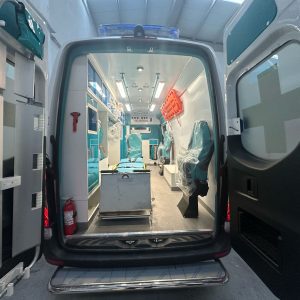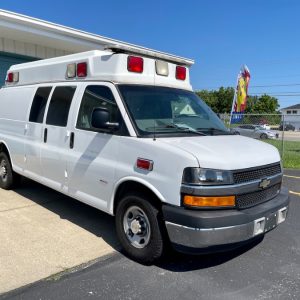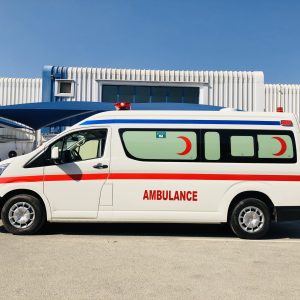Ambulance Manufacturing Companies; The ambulance manufacturing industry plays a critical role in healthcare and emergency response systems around the world. Ambulances are specialized vehicles equipped with medical supplies and technology to transport patients safely and quickly during medical emergencies.
The industry has evolved significantly over the past few decades. Early ambulances were simply passenger cars or trucks retrofitted with basic medical equipment. Today’s ambulances are complex, highly-engineered vehicles designed specifically for emergency medical services (EMS). Modern ambulances integrate advanced technology and equipment to serve as mobile treatment centers on the road.
Key players in the ambulance manufacturing industry include large automakers with specialized divisions focused on emergency vehicles. There are also niche manufacturers that specialize exclusively in building ambulances and EMS vehicles. The industry is highly regulated to ensure ambulances meet stringent safety and operational standards. Manufacturing ambulances requires expertise in automotive engineering as well as medical equipment and technology integration.
The ambulance manufacturing sector will continue expanding globally as demand increases for emergency medical transportation services. Ongoing innovation and new technologies are shaping the next generation of ambulances. The industry plays a vital public service role worldwide.
Ambulance Manufacturing Companies Major Players
The ambulance manufacturing industry is dominated by several major companies that produce a large share of ambulances worldwide. Some of the top ambulance manufacturers include:
- REV Group – One of the largest ambulance manufacturers globally, REV Group produces ambulances under several leading brands including Horton, Wheeled Coach, Road Rescue, and AEV. The company offers a full range of ambulance types and is a major supplier to government agencies.
- Braun Industries – A major ambulance builder in the U.S. for over 50 years, Braun offers a diverse range of ambulance models including the Chief XL, Patriot, and Liberty. The company focuses on innovation and manufactures its ambulances in the U.S.
- Demers Ambulances – A Canadian company that is one of the largest ambulance manufacturers in North America. Demers offers the quality and durability required for EMS vehicles and is known for its commitment to safety and reliability.
- Crestline Coach – A custom ambulance and specialty vehicle manufacturer based in Canada. Crestline builds ambulances on Ford, Freightliner, and International chassis and offers flexible designs to meet customer needs.
- Excellance, Inc. – Excellance focuses exclusively on ambulance manufacturing and produces over 1,000 ambulances each year. The company offers Mercedes-Benz and Ford-based ambulances built to order with the latest technology.
- Life Line Emergency Vehicles – Life Line has over 25 years of experience building ambulances and is a leading manufacturer of emergency response vehicles. They provide custom, high-quality ambulances at their U.S. manufacturing facilities.
- Marque Ambulance – A U.S. ambulance manufacturer specializing in building Type I, Type II and Type III ambulances on Ford chassis. Marque focuses on reliability, safety, and cost-effectiveness.
- Medix Specialty Vehicles – Medix designs and manufactures custom ambulances for emergency and non-emergency transport. They build on a variety of OEM chassis and utilize the latest innovations.
- Osage Ambulances – An ambulance manufacturer based in Missouri that builds on Chevrolet and Dodge chassis. Osage aims to provide quality, affordable ambulances to meet a range of needs.
- AEV Ambulances – Part of the REV Group, AEV is one of the largest ambulance producers globally. They offer a wide range of ambulances and specialty vehicles to customers worldwide.
Ambulance Manufacturing Companies Products and Services
Ambulance manufacturing companies produce a variety of vehicle types to meet the needs of emergency medical services. The most common types of ambulances include:
- Basic Life Support (BLS) – Used for non-emergency patient transport. Usually staffed by EMTs. Equipped for basic treatment and monitoring.
- Advanced Life Support (ALS) – Used for emergency calls and intensive care transport. Staffed by paramedics. Equipped with advanced medical equipment and cardiac monitors.
- Critical Care Transport – Used for critically ill patients needing ICU-level care during transport. Staffed by nurses or physicians. Equipped like a mobile ICU.
- Bariatric Ambulances – Designed to accommodate morbidly obese patients. Feature reinforced floors, wider doors, winches, and special stretchers.
- Neonatal Ambulances – Equipped with incubators, ventilators, and monitoring systems for transporting premature or critically ill newborns.
- Multi-Casualty Ambulances – Built to carry multiple patients at once, with bench seating and extra equipment. Used for mass casualty incidents.
- Tactical Ambulances – Built to operate in high-risk environments. Feature armor, run-flat tires, night vision, and defensive equipment. Used by law enforcement and military.
- Other Specialty Vehicles – Include off-road capable ambulances, amphibious ambulances, bus conversions, bicycles, motorcycles, boats, and even helicopters outfitted for medical transport.
Ambulance manufacturers offer complete customization to meet the specialized needs of EMS agencies. Vehicles can be outfitted with a range of medical devices, storage solutions, communication systems, and specialized accessories tailored to the operating environment and protocols.
Ambulance Manufacturing Companies Technology and Innovation
The ambulance manufacturing industry is constantly evolving to incorporate the latest technology and innovative features. Some of the key innovations shaping modern ambulances include:
- Advanced telematics systems – These allow ambulance crews to access real-time traffic data to optimize routing to emergencies. They can also enable location tracking and status monitoring from dispatch centers.
- Digital information systems – Touchscreen computers and tablets provide paramedics access to critical info like patient records, treatment procedures, drug databases etc. while on the move.
- Power load systems – Motorized stretchers and winches allow easy and safe loading/unloading of patients into the ambulance with minimum manual handling.
- Enhanced driver awareness systems – Backup cameras, proximity sensors, lane departure alerts etc. aid drivers, improving ambulance safety.
- Integrated lighting and sirens – LED emergency lights and high-powered sirens optimized for noise penetration in traffic ensure rapid response.
- Onboard oxygen systems – Built-in oxygen tanks and outlets allow paramedics to quickly administer oxygen to patients in critical condition.
- Advanced life support equipment – State-of-the-art defibrillators, ventilators and monitoring devices are standard inclusions to provide critical care.
- Ergonomic interiors – Clever storage solutions, anti-microbial surfaces, and barrier systems optimize infection control and ease of use for paramedics.
Leading manufacturers like Ford and Mercedes are pushing the technology envelope further with every new ambulance variant to enhance clinical capabilities and safety. The focus is firmly on harnessing technology to save more lives.
Safety and Regulations
Safety is a critical concern for ambulance manufacturers, as these vehicles transport injured or ill patients and medical personnel. There are strict safety standards and regulations that ambulance manufacturers must follow.
In the United States, the National Fire Protection Association (NFPA) sets the key safety standards for the design and manufacture of ambulances. NFPA 1917 outlines minimum safety requirements for new ambulances regarding vehicle design, patient compartment construction, electrical systems, emergency lighting, and more. Manufacturers must meet these standards and undergo testing to be certified. The standards cover important factors like ensuring electrical wiring is safe from shorts and fires, requiring easy access to safety equipment like fire extinguishers, mandating backup alarm systems in case of electrical failure, and specifying flame-resistant interiors.
The National Highway Traffic Safety Administration (NHTSA) also issues Federal Motor Vehicle Safety Standards that ambulance manufacturers must comply with. These include crashworthiness requirements, occupant protection standards, and other safety regulations for the chassis, body, and special equipment of ambulances. NHTSA has KKK specifications that detail minimum requirements for the different types of ambulances.
At the state level, departments of health regulate ambulance services and set additional safety requirements in some cases. Manufacturers must be aware of state-specific regulations that go beyond the national standards. Some states require additional emergency lighting configurations or specify maximum noise levels for sirens.
Staying up-to-date and in compliance with the latest safety standards and regulations is an important ongoing responsibility for ambulance manufacturers. Investing in safety testing, design improvements, advanced driver assistance systems, and the latest technology helps manufacturers meet the high safety demands for these essential emergency response vehicles.
Manufacturing Process
Ambulances are complex vehicles that require extensive manufacturing and customization. Here is an overview of how they are typically built:
The base vehicle begins as a stripped chassis from an automaker like Ford, GM, or Mercedes. The incomplete vehicle is sent to an ambulance manufacturer. There, the chassis is built up with the specialized ambulance components.
The patient care compartment is fabricated from aluminum or composites and attached to the chassis. This enclosed area in the back houses medical equipment, storage, stretchers, seating and climate control. The compartment walls and ceiling are insulated for temperature stability, sound dampening, and safety.
Electrical wiring for lighting, equipment, radios and other electronics is installed throughout the ambulance. Power supply and circuit protection are critical for safely operating so much electronics. Low voltage wiring is kept isolated from high voltage vehicle systems.
Oxygen, suction, and other gas lines are plumbed into the patient area. Tanks, manifolds and outlets are secured and tested. Medical gas installations follow National Fire Protection Association guidelines.
The interior is fully customized with cabinetry, stretchers, seats, flooring, and other fixtures. Ergonomics and ease of cleaning are important design factors. Safety restraints and crash protection measures are incorporated.
Graphics, reflectors, emergency lights, sirens and other exterior equipment are added to finish the ambulance. Radio antenna mounts, scene lights, running boards, and storage compartments are installed.
The completed ambulance goes through quality assurance testing and inspection before final delivery. This validates all vehicle, medical, communications and safety systems function properly. Ambulances must meet or exceed stringent federal, state and industry standards.
Ambulance Manufacturing Companies Industry Trends
The ambulance manufacturing industry has undergone some significant changes in recent years due to emerging trends and innovations. Some of the key trends shaping the industry include:
- Focus on safety and efficiency: There is an increased focus on developing ambulances that enhance safety for patients and providers while also improving fuel efficiency and reducing emissions. Features like improved suspension, backup cameras, lane departure warning systems are becoming more common.
- Electric and hybrid models: With a push towards sustainability, some manufacturers are exploring electric and hybrid electric ambulances. These models can significantly reduce emissions and operating costs, though range and charging infrastructure remain challenges.
- Advanced telematics and connectivity: New ambulances increasingly have integrated WiFi, Bluetooth, GPS navigation and tracking capabilities. This allows for real-time fleet monitoring, navigation, patient telemetry and better integration with electronic patient care reporting systems.
- Modular design: Manufacturers are shifting towards more modular interior designs that allow greater customization and flexibility. This enables easier upgrading of technology and reconfiguration to meet evolving needs.
- Bariatric accommodations: To serve obese patients better, new bariatric ambulances feature wider doors, reinforced floors, winches, and ramps. This ensures patient and provider safety during loading and transportation.
- Autonomous features: While fully autonomous ambulances are still a ways off, new models incorporate autonomous emergency braking, lane keeping assist, adaptive cruise control and other ADAS features to improve safety.
Market Size and Growth
The ambulance manufacturing industry has seen steady growth over the past decade. According to market research, the global ambulance services market size was valued at USD 14.9 billion in 2021 and is projected to reach USD 26.9 billion by 2030, growing at a CAGR of 6.7% from 2022 to 2030.
North America currently dominates the ambulance services market due to high healthcare expenditure, growing geriatric population, and increasing prevalence of chronic diseases. However, the Asia Pacific region is expected to exhibit the highest CAGR during the forecast period owing to rising medical tourism and investments in healthcare infrastructure in developing countries like India and China.
Several factors are driving growth in the ambulance manufacturing market:
- Aging populations with more medical transportation needs
- Advances in ambulance technology and vehicle design
- Increased focus on emergency preparedness and response
- Higher utilization of ambulance services
- Growth of the overall healthcare industry
Key players in ambulance manufacturing are expanding production capabilities to meet increasing demand. New product innovations and customization options are being introduced to gain market share. Overall, the ambulance manufacturing industry looks poised for further expansion as healthcare systems continue to evolve globally.
Challenges
The ambulance manufacturing industry faces several challenges that impact growth and operations. Some key issues include:
High Costs and Tight Margins – Ambulances are complex vehicles that require extensive design, engineering and customization. This leads to high manufacturing costs that make it difficult to achieve adequate profit margins, especially for smaller companies. Maintaining profitability is a constant struggle.
Regulations and Safety Standards – Ambulances must adhere to strict regulations and meet certain safety certifications. Keeping up with changing requirements and certifications requires significant investments in testing and modifications. This adds to costs and affects time-to-market.
Innovation and Technology Adoption – Integrating the latest medical equipment, communications and vehicle technologies is important but also expensive. Lack of funding and long equipment refresh cycles make it hard for manufacturers to innovate and adopt new technologies quickly.
Customization and Configurations – Each client has specific customization needs based on vehicle types, equipment, layouts and branding. Highly customized and low volume manufacturing leads to production inefficiencies and inflated costs. Standardization is difficult.
Raw Material Cost Fluctuations – Ambulances use many raw materials like aluminum, steel, glass, plastics, rubber etc. Raw material price volatility directly impacts manufacturing costs and margins. Maintaining stable supply chains is an issue.
Skilled Labor Shortages – Highly skilled workers are required for ambulance production and customization. Shortages of automotive engineers, technicians and specialty skilled labor affects manufacturing capacity and quality.
Overcoming these challenges requires strategic investments, process improvements, skilled teams, technology adoption and close collaboration with clients and regulators. Addressing these issues can help ambulance manufacturers enhance competitiveness and profitability.
Ambulance Manufacturing Companies Future Outlook
The ambulance manufacturing industry is likely to continue evolving in the coming years. Here are some key trends that point to the future direction of the industry:
- Continued focus on safety and efficiency: Safety and efficiency have always been top priorities in ambulance design, and this will continue. Manufacturers will aim to improve ambulance safety through technological innovations like collision avoidance systems, better restraints, and use of high-strength materials. There will also be a push towards more fuel-efficient and eco-friendly ambulance models.
- More advanced telematics and connectivity: Ambulances of the future will be highly connected vehicles, transmitting patient data and vehicle diagnostics in real-time. This allows for better fleet management and preventative maintenance. Manufacturers will integrate more advanced telematics, data analytics, and cloud-based solutions into their ambulance offerings.
- Autonomous driving capabilities: While fully driverless ambulances may still be far off, ambulance manufacturers will start integrating more ADAS features and partial autonomous driving capabilities into vehicles. This includes features like automatic braking, lane keeping assist, adaptive cruise control, etc. which enhance safety and take some driver workload off.
- Personalized and precision medicine: As healthcare gets more personalized, ambulance manufacturers will aim to create more modular and customizable ambulance interiors. This allows them to tailor the ambulance setup to the precise needs of the patient and enable more specialized care while in transit.
- Alternative fuels and electrification: To meet emissions standards and sustainability goals, ambulance manufacturers will offer more hybrid, electric and alternative fuel models. For e.g. hydrogen fuel cell ambulances are gaining interest. This will decrease the environmental impact of ambulance fleets.
Overall, the ambulance manufacturing industry will evolve to leverage new technologies and innovations to enhance safety, efficiency, connectivity and sustainability of ambulances. Manufacturers will adapt their offerings to meet the changing demands of healthcare providers and EMS agencies.













